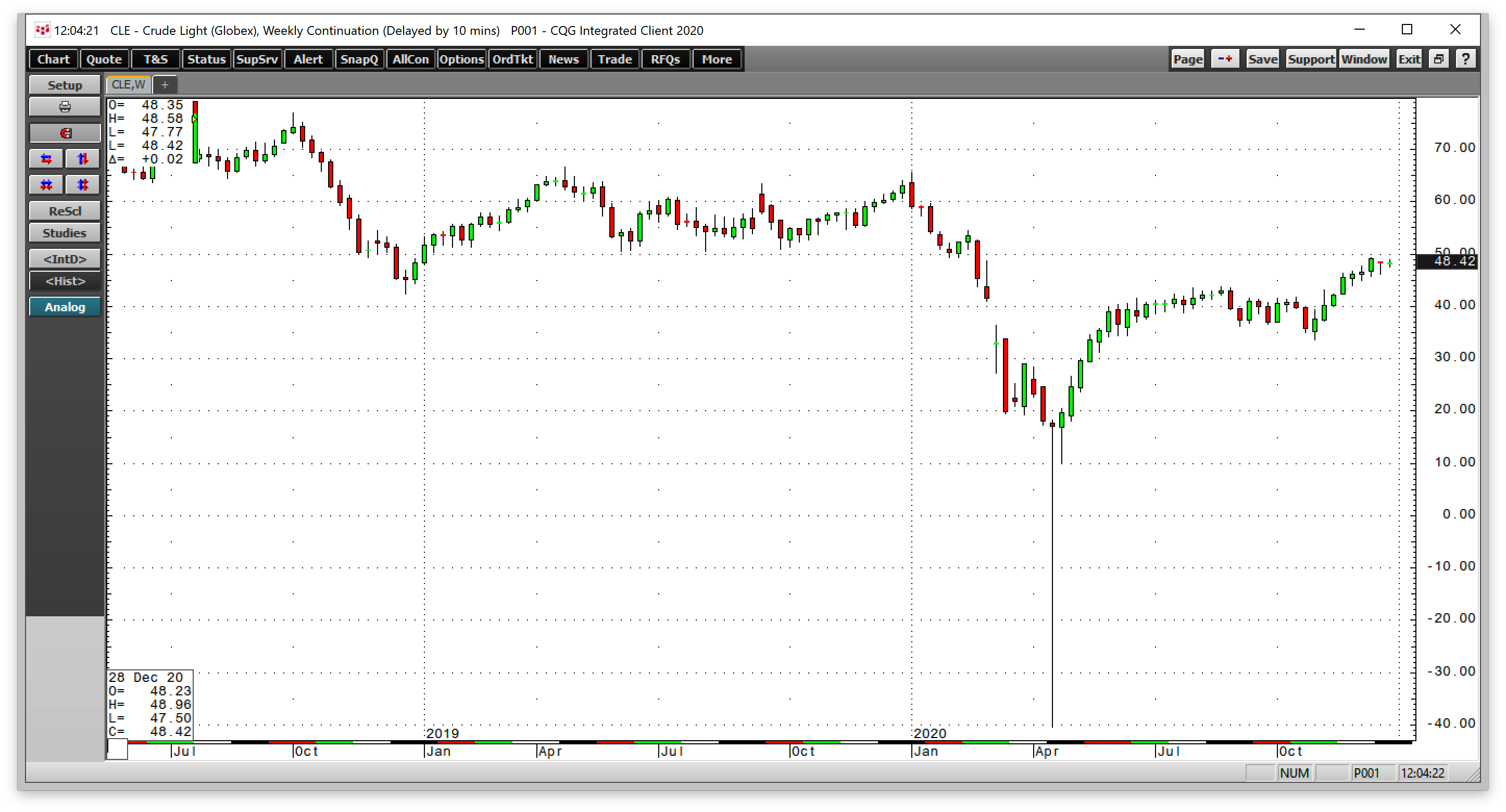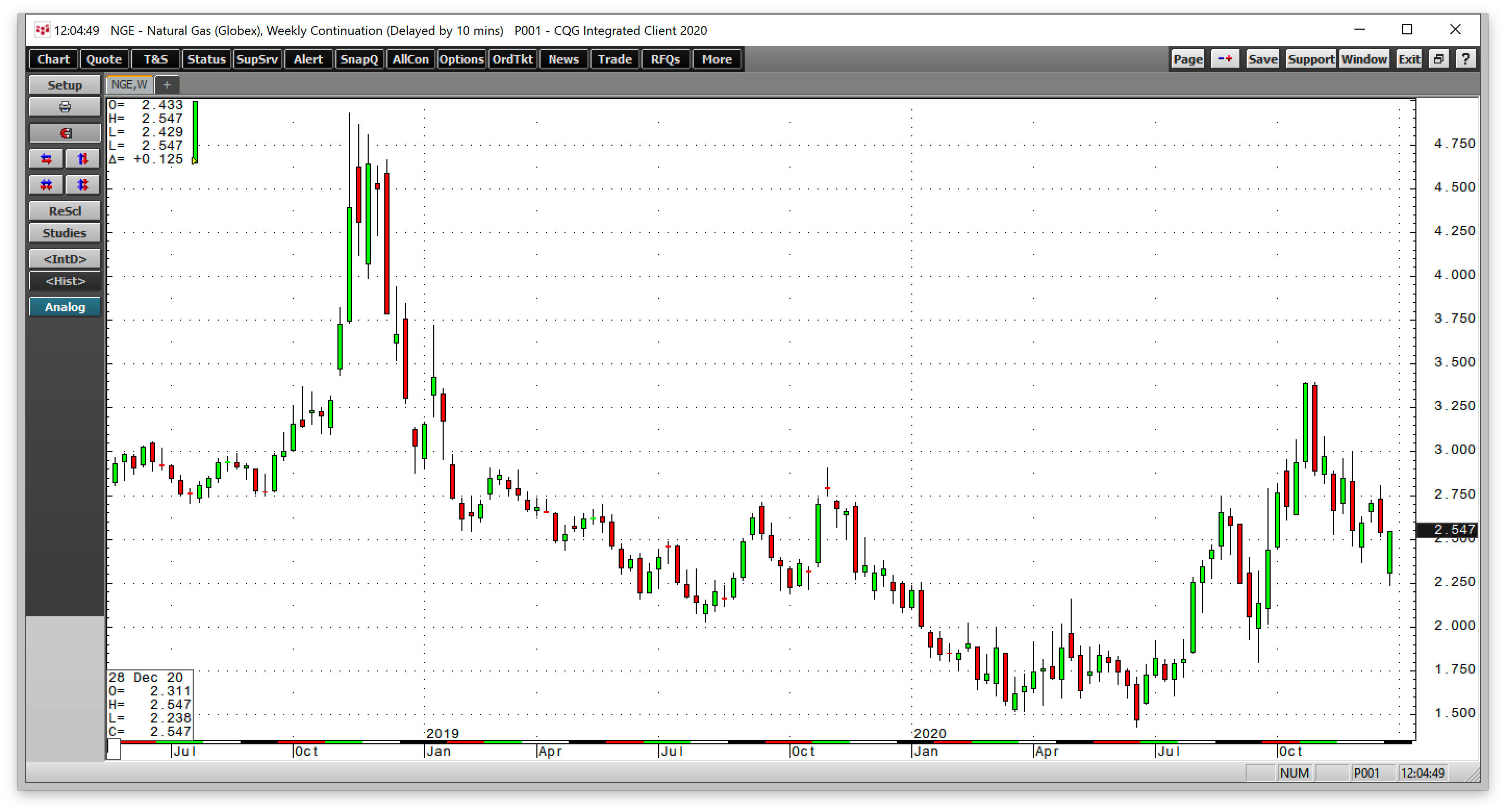This article was written exclusively for Investing.com
- A wild 2020 in oil and gas futures markets
- US politics could hand pricing power back to OPEC+
- Demand will return when vaccines achieve herd immunity
- The global financial and political landscapes support all commodity prices
Crude oil is moving into 2021 on a bullish note, while natural gas remains under pressure. The energy commodities experienced significant selling pressure in 2020 as energy demand evaporated during the global pandemic.
Nearby NYMEX crude oil futures fell to the lowest price since trading began in the 1980s on Apr. 20 when it dropped below zero to a low of negative $40.32 per barrel. The delivery point for NYMEX futures is in Cushing, Oklahoma, making the energy commodity landlocked.
A lack of storage capacity drove the price into negative territory as the energy commodity became a bearish hot potato for those holding long positions in the expiring May 2020 futures contract. Brent crude oil, the other benchmark futures contract that trades on the Intercontinental Exchange, is seaborne petroleum. Brent futures fell to the lowest price of this century at $16 per barrel in late April.
Meanwhile, NYMEX natural gas futures declined to a quarter-of-a-century low in late June when they fell to a low of $1.432 per MMBtu. Oil and gas prices recovered and were appreciably higher at the end of 2020, with nearby NYMEX and Brent crude oil futures at $48.52 and $51.80, respectively, and natural gas above $2.50 per MMBtu. As we head into 2021, the energy markets are likely to be volatile, but the directional bias is higher.
A wild 2020 in oil and gas futures markets
The 2020 high in the nearby NYMEX crude oil futures market came during the first week of the year. A little under five months later, the price was over $100 per barrel lower and below zero.

Source, all charts: CQG
The chart above highlights the decline to a low of negative $40.32 during the week of Apr. 20 and recovery to over $48 per barrel by the end of 2020. The WTI futures for delivery in Cushing, Oklahoma, traded in a $105.97 range during the year that ended last week.
The closing price for WTI was $17.13 off the high and $88.84 above the low.

Nearby natural gas futures for delivery at the Henry Hub in Erath, Louisiana, traded in a $1.964 range in 2020 with the low coming in late June at $1.432 and the high on Oct. 30 at $3.396 per MMBtu. At the $2.539 level on Dec. 31, natural gas was $1.107 above the low and $0.857 below the high.
Volatility is a nightmare for investors, but it creates a paradise of opportunities for traders with their fingers on the pulse of markets.
US politics could hand pricing power back to OPEC+
The incoming Biden administration has pledged to shift US energy policy towards a greener approach to powering the nation and the world. The regulatory environment will become a lot stricter as it moves from four years of the drill-baby-drill and frack-baby-frack policies of the Trump administration to supporting alternative power sources that do not include fossil fuels.
Less fracking and higher regulatory costs are likely to cause US oil and gas production to decline over the coming years. The Jan. 5 runoff elections in Georgia will determine how far the incoming administration can go when limiting hydrocarbon output as it will determine the balance of power in the Senate. A victory by Republicans would set the stage for negotiation and compromise, and could restrict the green agenda.
If, however, Democrats capture both Senate seats, it will give the Biden administration clear sailing for its initiatives, making the energy policy shift more dramatic. In any case, President-elect Biden will rejoin the Paris climate accord, and fossil fuel production is likely to decline from levels seen over the past years.
In March 2020, US crude oil output rose to a record level at 13.1 million barrels per day. We are not likely to see production return to that level in the foreseeable future. As Russian and Saudi Arabian production rises above US output, the pricing power could tilt back to OPEC+. The cartel members want crude oil prices at the highest possible level.
For decades, US energy policy was to achieve independence from foreign oil. As regulations increase, the decline in production could cause increasing dependence on OPEC+ as crude oil is still a critical energy source in the US and the world. LNG remains a growing business in natural gas that could siphon off US supplies if the new production environment impedes output.
Demand will return when vaccines achieve herd immunity
The low oil and gas prices in 2020 were a function of demand evaporation because of the global pandemic. As people worldwide worked from home, limited travel, and practiced social distancing, the need for energy declined, sending WTI crude oil to an all-time low and natural gas to its lowest price since 1995.
Vaccines that create herd immunity could cause a sudden spike in demand for energy as people escape the confines of homes, return to offices, and take those long overdue vacations. OPEC+ cut production in 2020 by a record amount. The cartel will continue to taper its cuts, but a US energy policy shift may offset any increases from the cartel over the coming months and years.
After the demand evaporation of 2020, the coronavirus’s aftermath could create a demand surge in 2021.
The global financial and political landscapes support all commodity prices
The worldwide financial landscape supports higher commodity prices. The US dollar index declined from the highest level since 2002 at 103.96 in March 2020 to below the 90 level at the end of the year, the lowest level since 2018. The dollar is the world’s reserve currency and the pricing mechanism for most commodities, including energy. A falling dollar tends to support higher commodity prices.
Moreover, the monetary and fiscal policies of central banks and governments remain highly accommodative. A tidal wave of liquidity in the form of low short-term interest rates and quantitative easing programs that depress rates further out along the yield curve stimulate borrowing and spending and inhibit saving. Monetary policies lower the carrying cost for commodity inventories. Simultaneously, the shift in Fed policy from a 2% inflation target to a 2% average encourages inflation, which is bullish for raw material prices.
Government stimulus programs increase deficits and the money supply. Central bank liquidity also causes the money supply to expand. The world financial system planted many inflationary seeds in 2020 that are likely to bloom in the coming months and years. While the 2020 pandemic was far different from the 2008 global financial crisis, central banks and governments utilized the same tools to stabilize the worldwide economy. From 2008 through 2011, commodity prices rallied to multi-year, and in some cases, all-time highs. If history repeats, we should expect the same price action in raw material markets over the coming years.
From a political perspective, US energy output will decline under the Biden Administration. The Middle East is still home to over half the world’s crude oil reserves. The assassination of Iran’s top nuclear scientist in late 2020 highlights the Middle East’s turbulent political nature. Moreover, as Israel and many Arab nations have strengthened ties, the gulf with Iran widened. Any increase in hostilities in the area that impact production, refining, or logistical routes could cause short-term price spikes in crude oil futures markets. Nothing drives the price of oil higher, like a supply scare.
As we move into 2021, the political and financial landscapes for commodities are the most bullish in years. Bull markets rarely move in a straight line. Buying commodities on price dips over the coming weeks and months could be the optimal approach to the asset class for the coming year.
Crude oil and natural gas prices are likely to continue to experience lots of volatility in 2021. We will not have to wait long for the first significant event of the new year. The Jan. 5 elections in Georgia will determine the extent of the shift in US energy policy. However, it is always the unknown that tends to cause the most substantial price volatility.
In 2020, it was the pandemic that came out of the blue. In 2021, an event we have yet to consider—and which may still not be on our radar—is likely to be the factor that causes the most price variance.
